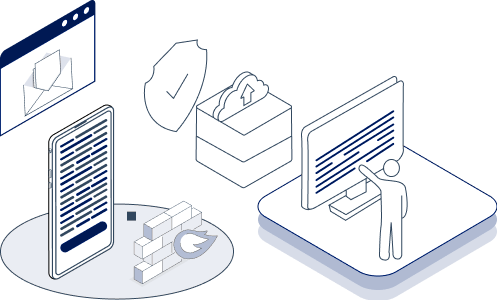Enhance your cybersecurity defenses with Mindfire's Deception Technology Services. Stay ahead of threats. Fortify your security today. Contact us now.
ExploreWith our Cyber Security Consultant
Mindfire, a leading provider in the field of cybersecurity, recognizes the growing threat of sophisticated cyber crimes and the need for organizations to take a proactive approach to safeguarding their IT infrastructure. In response to this ever-evolving landscape, we offer cutting-edge Deception Technology Services.
In today's cybersecurity landscape, a proactive approach is crucial to detecting and terminating malicious activities. We recognize the possibility of hackers infiltrating your tech devices and operating undetected within your systems. The longer these attackers go unnoticed, the higher the risk of potential damage.
Mindfire's expertise lies in creating a secure environment through the strategic implementation of deception tools. We meticulously design and deploy deceptive assets, mirroring the systems and pathways that attackers would typically utilize to target your essential assets. By placing these realistic decoys alongside your organization's actual assets across your network, we entice cybercriminals into carefully laid traps.
Mindfire’s deception technology solutions perform three core tasks when for lateral movement defence:

Our cybersecurity deception technology preempts attacks by discovering and removing cached credentials, network connections and possible attack pathways.
Our security technicians implement deception tactics and decoys to disorient and mislead malicious actors. They are led into believing they have successfully accessed your network and eventually reveal themselves.
We use powerful AI technology to provide information about the source and the target of cyberattacks. This enables your organisation to respond effectively to criminal activity and remediate incidents.
Mindfire uses a systematic approach to deception that involves the following steps:
Types of deception technology
After consultations with your organisation’s management and IT security team, we weave deceptive technology software into your network. We use various types of intruder traps, including:
Scanning tools for internal surveillance
Hacktivists are tricked into interacting with fake assets, where they use scanning tools for internal surveillance to determine their lateral movements. The detection tools detect the usage of these scanning tools and alert security teams of a breach.
We use leading techniques
We use leading cyber security deception technology to define a honey user or decoy account with a common name linked to administrators. Hackers will usually try to guess the passwords to such accounts, but any login attempts trigger alerts.
Automatically alerted of fake credentials are used
Attackers are able to launch a pass-the-hash attack or clear text credentials without the use of malware. Mindfire teams inject honey credentials on your network’s endpoints to keep track of intruder activity. You will be automatically alerted if any of these fake credentials are used.
The ultimate goal of cybercriminals
The ultimate goal of cybercriminals is to exfiltrate sensitive information. They do this by zipping and copying files to a cloud storage account or external server. By specifying honey files, we give you the ability to monitor activity on fake files and keep authentic assets secure.
Deception tools lock them out of your network
After bad actors have accessed the deception environment, they cannot enter your business’ real IT environment. Deception tools lock them out of your network, and we can determine their target and method of entry through threat intelligence techniques.
Although the deception technology industry is fairly small compared to other cybersecurity solutions, deception technology are thriving. As more products are developed, the global deception technology market is expected to hit $4.15 billion (£3.5 billion) by 2026. It may seem like a daunting task to navigate this space when looking for the best deception technology for cyber defence. Mindfire offers the most advanced deception products that meet and exceed the key requirements of effective deception technologies. These requirements include:
Integration with security tools
Like many other businesses, you might have various security tools that work concurrently to protect your systems. From threat detection and prevention tools to firewalls and vulnerability management software, these tools are essential to the security of your network. Before investing in products, confirm that they can easily share data with your existing tools.
Flexibility
How deception technology works? Mindfire creates deception technology that is agile and flexible. This means it works across all vulnerable areas of your IT infrastructure. These include:
Ability to scale
To achieve comprehensive coverage, it is essential for an organization's security measures to be applied across its entire IT environment. As operations scale up, security systems must adapt and expand in tandem. At our company, we offer scalable solutions that can be customized to meet the unique requirements of organizations, regardless of their size.
Centralised Decoy Management
As your organisation grows, the number of endpoints increases, all of which will ideally have individual decoys. Managing these decoys can become a very complicated, time-consuming process. Look for deception technology companies that offer centralised management of decoys via a centralised console.
Capable of staying indistinguishable
Successful deception technology implementation must remain invisible to the attacker. If they suspect that they are interacting with deceptive assets, they may launch more brutal attacks or use more advanced hacking tools to evade traps.
By utilizing advanced software for deception, your organization can swiftly detect and respond to incidents, thwarting attackers before they can compromise your actual IT resources. This enables you to gain a comprehensive understanding of attacker behavior and glean valuable insights to enhance your response strategies for future security breaches.
Some major benefits provided by using expert deception technology providers such as Mindfire include:

If you are looking for reliable and efficient solutions to enhance your business operations, Mindfire is the perfect partner for you. Contact us today to learn more about our services and how we can help you achieve your goals. Whether you need Cyber Security Services, Managed Security Services (MSS), Consulting Services, Cyber Risk Management Services, Cloud Services, Digital Services, or Digital Transformation, our team of experts is here to assist you every step of the way. Don't hesitate to get in touch with us and take your business to the next level with Mindfire.
